CONSTELLATION GUIDE
Last updated: 12 July 2001
CONSTELLATION GUIDE |
"GO TO"....ANDROMEDA
....yes, there IS a constellation out there surrounding that famous galaxy!
From: sherrodc@ipa.net (Clay Sherrod)
This is the 22nd Constellation Guide, "GO TO ANDROMEDA" of the series "GO TO GUIDES for the ETX and LX 90 Telescope Users". Unlike our "GO TO" guides of late, this constellation features MANY wonderful deep sky objects, interesting stars and much wonderful historical interest. Yet Andromeda is a notably "ignored" constellation by the amateur astronomer, mainly because of all the focus of attention to the great and famous galaxy within it Messier 31 - the "Andromeda Galaxy."
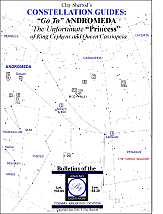
Andromeda (pronounced "an-DRAW-me-duh" In Greek legend is a very important mythological figure, the daughter of both Queen Cassiopeia and King Cepheus. As mentioned in previous constellation guides, the whole stellar affair of Cassiopeia with other immortals and mortals is something right out of a soap opera and no doubt much less befitting a Queen, particularly one immortalized in the beautiful heavens. Indeed, unfaithfulness to Cepheus in an illicit affair of Cassiopeia with the strong and dashing Perseus ultimately led to her to be banished forever to the sky chained to her thrown, encircling the pole star forever.
Andromeda, fortunately born before her mother's en-throned demise, has not been much more fortunate in legend....thanks once again to momma. Cassiopeia - a braggart as well as a hussy - confronted the great sea nymphs of Neptune, beautiful to all who saw them, that she was far more beautiful than they and, indeed, more beautiful than ANY living (or immortal!) woman. Jealousy raged and the nymphs cried to Neptune to do something to place their beauty back to the highest ranks among mortal eyes.
As God of the Sea, mighty Neptune ordered the great whale monster Cetus to ravage the kingdom and the family of Cepheus to avenge the nymphs' forsaken achievement of such fabulous beauty. But Cepheus had wise sages (or a television psychic hot line) who informed him of the impending attack and learned that he COULD prevent the attack by the great sea beast if he merely sacrificed his daughter, Andromeda....NOT the lovely Cassiopeia mind you, but his innocent daughter. Well, that was okay by Cepheus so he arranged to have her taken and bodily chained to a large cragged rock overlooking the ocean to be devoured by the great whale.
That's what Dads are for.
Perseus - here is where it really gets interesting in light of the fact that we already know that Perseus has been "fooling around" with Andromeda's mother - heard of her plight and went boldly to her rescue, with the head of the "snaky" Medusa in his hand which, upon seeing it the monster turned instantly to stone. As just reward, mythology tells us that Perseus in turn asked Cepheus (actually "demanded") for Andromeda's hand in marriage, to which the great and wise King hastily agreed. Now THAT is one big, happy, Greek god-of-a-family even in today's time!
This whole story begs the questions: 1) what was Perseus doing with Cassiopeia while he was pursuing Andromeda's hand in marriage? 2) did the Authorities come and get King Cepheus (see figure below) for child abuse and endangerment? and 2) do all sea monsters sink in the ocean when turned to stone or do some of them rise into the sky as stars as did Cetus?
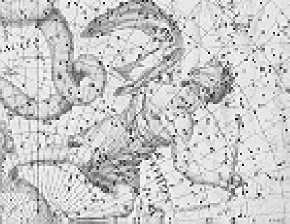
ORIGINAL DRAWING FROM BODE'S STAR ATLAS
In addition to the famed Andromeda galaxy which is discussed in full here, Andromeda is loaded with nice objects for your telescope; there are at least three bright galaxies (all huddled around Messier 31), two nice galactic clusters and many very nice multiple and variable stars that we will explore.
To the naked eye, the constellation of Andromeda might appear at first a bit uninteresting, as there are no very bright stars nor conspicuous asterisms (star patterns) on which to focus your attention; nonetheless, the naked eye splendor of Messier 31 as it stretches across the central portion of this constellation like a ghost in flight is enough to clearly motivate even the novice observer to explore her boundaries. Adding even more to the naked eye spectacle on the clearest and darkest night is the even-larger (but fainter) Messier 33, the Triangulum galaxy, or "Pinwheel" to the immediate southeast of the great galaxy. Both are absolutely breathtaking in good binoculars on those crisp fall evenings of very deep sky.
The photograph below shows the constellation and its famous galaxy rising above 3,000 foot Wilhelmina Mountain in western Arkansas in 1972 through a piggyback guided Nikon camera with 50mm lens. Note the darkness of the skies all the way to the horizon some 20 years ago and the "sky glow" toward the middle of the photograph....that glow is caused by reflection of ionized dust particles that follow in the wake of the Earth in its orbit....today it is caused more likely by high pressure lighting on Earth. Facing this same direction today from this old observatory site is now a major shopping center with 24-hour lighting.
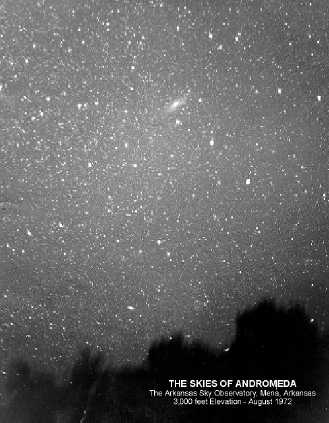
As with every "GO TO" TOUR guide, each GO TO object in Andromeda is discussed for your telescope regarding the type of conditions necessary for you to view it optimally for discern the very faintest details.........magnifications and aperture necessary for most objects, and much, much more. This is YOUR complete GUIDE to get you on your way to exploring the best (and few!) objects in these two constellations. The following listing of "BEST" objects contains the finest or most interesting from my own observing experience and preference.
Use the attached star chart and the following Guide as an excellent reference for your next star party itinerary, or a beginning for further study into the thousands of objects visible in this part of the sky. Truly these extensive Constellation Study Guides will most definitely put your AutoStar to work for you in the most efficient and enjoyable way possible! As a matter of fact, MANY AutoStar users are now programming their own "Tours" based on these guides, using each constellation as a separate GO TO Tour for the AutoStar library that can be added in or deleted through the main edit screen on your PC or MAC computer.
We hope you enjoy these comprehensive GUIDES to touring the constellations via your AutoStar and its computer-driven telescope. Each new installment is complete with diagrams, charts and illustrations that you will find nowhere else. Please let us hear YOUR feedback and your observations of each and every constellation after YOU have toured its vast reaches of our skies!
-----------------------------------
YOUR ANDROMEDA CONCISE DIRECTORY OF INTERESTING OBJECTS -
Attempt to pry your telescope away from the coordinates [R.A. 00h 40m / DEC +41 degrees 00m] just long enough to explore the many other wonderful celestial objects this rich constellation has to offer. Afterwards, you can return to the splendor of the closest galaxy that resembles our own to the Earth!
I have chosen the finest (or most interesting) 13 objects in this ANDROMEDA "GO TO" TOUR (there are 11 targets listed, but ONE GO TO for #11 - Messiers 31, 32 and ngc205); as with all GUIDES, all objects listed below will be visible in most telescopes (some naked eye) from the ETX 60 through the LX 90; of course larger apertures may "show" an object a bit closer and "better," but frequently a wide field and low power view is more desirable than aperture for FINDING the objects initially. Indeed, I strongly encourage you first FIND the target object, or its approximate location through your GO TO function with your lowest power and then - once IDENTIFIED positively - move up slowly in steps with magnification if necessary. Remember, not all objects "like" magnification. Sometimes better "field of view" (such as the wonderful wide fields provided by the ETX 60 and 70) is desired over light gathering (like the big LX 90) and magnification.
The rule for determining "optimum magnification" is that: 1) too low power results in sky background glow detracting or diminishing the contrast against the deep sky object; 2) too high magnification darkens BOTH the sky background AND the object; 3) medium magnification can be achieved at which you have MAXIMUM contrast between the object and its darkened background sky. I have found through three decades of direct observing that about 15x per inch aperture (36x for the ETX 60/70; 55x for the ETX 90; 75x for the ETX 125; and, 125x for the LX 90).for deep sky observing is PERFECT for most objects. That being said, always remember that DOUBLE or multiple stars require whatever power you can crank out....the seeing conditions are the limiting factor here.
For my complete and comprehensive discussion regarding seeing conditions and sky transparency, see: http://www.weasner.com/etx/buyer-newuser-tips/seeing.html .
With all deep sky objects, avoid attempting to observe when the moon is in the sky, even a very thin crescent, as its brightness in the sky will overshadow the very dim contrast afforded by even the brightest deep sky object; if you see the object at all against moonlight, you will NOT see the subtle outlying areas or the full detail of what is presented.
Andromeda is a dominant constellation of fall skies. It is in that "quiet zone" that follows the spectacular summer Milky Way clouds and wealth of rich deep sky objects.....yet precedes the equally rich skies of winter, harboring the beautiful and bright constellations of Orion, Taurus, Cassiopeia and Canis Major. Andromeda rises almost due NORTHEAST for mid-northern latitudes about 10 p.m. local time during the first week of July. High in the north, it takes a while to reach the meridian, or highest point in the sky, culminating at 6 a.m. on that same night! However, midnight culmination - when it is on the meridian at midnight each year - occurs always on about October 5.
As with all of the "GO TO" TOUR constellation lists, I recommend a good star atlas and/or chart which will list all the finest objects, constellation-by-constellation. One very handy reference guide is the PETERSON FIELD GUIDE TO THE STARS AND PLANETS, which features complete lists with declinations, right ascensions, magnitudes, and all pertinent information for you to expand your observing horizons beyond this brief GUIDE.
Note that your AutoStar will NOT have every object listed on every constellation GO TO tour....this is intentional. You can access some of the most interesting objects of the sky directly from their coordinates. It is quite simple as you merely enter these coordinates as follows in the 10-step process:
1) Press the "MODE" key and hold down for 3 seconds and release;
2) Displayed will be the current Right Ascension and Declination of the center of field of view of where your telescope is presently pointed (assuming that you have properly aligned from "home position");
3) [NOTE: if you have the Meade electric focuser attached to any of the ETX or LX telescopes, holding down the "MODE" key will bring up the "Focus" command first....merely scroll (lower right scroll key) down one step to access the RA and DEC to enter your desired coordinates]
4) Press the "GO TO" button on AutoStar;
5) This will change the display and you will note the cursor blinking over the first digit of RIGHT ASCENSION (R.A.); merely use the number keys and dial in the R.A. of the object you are searching for;
6) When done, press "Enter;"
7) This moves the blinking cursor over the "DEC" coordinates;
8) [NOTE: the declination, unlike R.A., can be either positive or negative and you will see the "+" or "-" sign displayed depending on where your telescope is aimed at that time; if it is NOT the desired setting (plus or minus), merely use your arrow key to move the blinking cursor OVER the "+" or "-" sign and change by using either of your lower corner SCROLL KEYS;
9) Proceed to enter the DEC using number keys;
10) Press either "Enter" or "Go To" when finished and the telescope begins slewing to your desired object!!
The constellation tour Star Chart above (click on and save to a file on your PC; then open it and re-size to fit the page and print for a very handy at-the-scope star chart) will get you started on your journey for this constellation.
Following is the concise object list for your "GO TO" TOUR of ANDROMEDA; you may wish to find the majority of the objects from the AutoStar Library (for example, you can easily go to the WONDERFUL Messier 31 if you pull up "Object/Deep Sky/Messier/..then type in '31'...." and then press "Enter", followed by "GO TO" to access this naked-eye galaxy. On the other hand, if you want to experiment and become a "better AutoStar user" try entering the exact R.A. and DEC coordinates of that object as described above after holding down the MODE key. You will find the accuracy of entered GO TO's to be somewhat less than those stored in AutoStar, but the capability of acquiring unlisted objects is fantastic!
You will access your FIRST GOTO target - (usually the brightest star in each constellation) - via the command "SETUP / OBJECT / STAR / NAMED....and scroll to "Alpheratz"", then press "Enter" and subsequently "GO TO" to move your this bright star. Remember also that the Andromeda Galaxy is listed among the "named" objects. So, likewise for that object you might merely go to SETUP/OBJECT/DEEP SKY/NAMED....and then scroll alphabetically to the "A's" if you are not already there; press "enter" and then GO TO and your scope is off and running!
You may also access the constellation by: SETUP/OBJECT/CONSTELLATION/Andromeda.....Enter....GO TO.
OBJECT 1:
bright star - ALPHERATZ (alpha Andromedae) - R.A. 00h' 06' / DEC +28 49 - Magnitude: 2.2
OBJECT 2:
bright star/double/galaxy - MIRACH (beta And) - R.A. 01h 07' / DEC + 35 21 - Mag. 2.0, great target!
OBJECT 3:
double star - ALMACH (gamma And) - R.A. 02h 01' / DEC + 42 06 - Mags: 2.1 & 5.1 - VERY close!
OBJECT 4:
test double - 36 And. - R.A. 00h 52' / DEC + 23 21 - The "standard" for testing an 8" telescope!!
OBJECT 5:
great double for ETX 60 and all - 59 And. R.A. 02h 09' / DEC + 38 48 - Mags: 6 & 6.7 - wonderful star.
OBJECT 6:
Red Dwarf double! - Groombridge34 - R.A. 00h 16' / DEC + 43 44 - Mags: 8.1 & 10.9 - Really neat!
OBJECT 7:
variable/odd nova? - Z And.- R.A. 23h 31' / DEC + 48 32 - a star on a wild ride! Catch it while you can!
OBJECT 8:
galactic cluster - ngc0752 - R.A. 01h 55' / DEC + 37 25 - Mag: 7.0, large, 70 stars over huge area!
OBJECT 9:
edge on spiral - ngc891 - R.A. 02h 19' / DEC + 42 07 - Mag: 11.8 - faint but "see-able" in the ETX 90+
OBJECT 10:
planetary nebula - ngc7662 - R.A. 23h 23' / DEC + 42 12 - Mag: 8.9, very nice green-blue
OBJECT 11:
Andromeda galaxy, Messier 32, ngc205 - R.A. 00 40' / DEC + 40 00 - Three galaxies for one price!
---------------------------------
A VISUAL GUIDE TO OUR DEEP SKY OBJECTS IN ANDROMEDA
Object 1 - Our "Starting" Bright Star - "ALPHERATZ" (alpha Andromedae)
Also known as "Sirrah," this star originally was designated by the early Arabic "namers of the stars" as the "horse's naval," in reference to an early association with the constellation of Pegasus, the winged horse. It is quite easy to confuse this star as one belonging to Pegasus since it marks the northeast corner of "The Great Square" (see the chart above) of Pegasus. Using this relatively bright star has always been a benchmark for quick allocating of the great Andromeda Galaxy for naked eye observers. Alpheratz is at a distance of about 120 light years from Earth, making it a relatively close neighbor.
Object 2 - MIRACH - (beta Andromedae) and NGC 404
Here is actually a "triple treat" in our Andromeda guide. Beta Andromedae, actually brighter at magnitude 2.0 than Alpha, is a double star for larger amateur telescopes. "Mirach" is about half the distance to us as Alpheratz and shows a true companion of the 14th magnitude (should be visible in the 8" scope under perfectly dark skies and medium-high (about 200x) power nearly due south (Position Angle 202 degrees) about 28" arc away (that is fairly close, about half the diameter of Jupiter would seem in the same eyepiece). It "might" be glimpsed on very dark nights with the ETX 125, as there are some estimates giving this faint companion a magnitude of about 13.6. Easily visible, but not bright, in the 5" scope will be NGC 404, located northwest of Beta only 6' arc! This will place it in the same field of view with the 26mm eyepiece and some of even higher magnification with that scope and the LX 90. At 12th magnitude, this elliptical galaxy is too faint to be seen in the ETX 90.
Object 3 - ALMACH - (gamma Andromedae) - A very nice but tough double star
Currently this double star is separated by nearly its maximum as viewed from Earth; with a period of 61 years, it past periastron (most distant point from our perspective) in 1981, but still is located nearly 1" ENE of the brighter (magnitude 2.1) star. The companion is magnitude 5.1 and the color contrast between these two is fantastic....actually in smaller telescopes (you likely might see and elongation in the ETX 90, two "bumps" in the ETX 125 and clear separation in the LX 90) it is the contrasting COLOR that can separate the two stars....NOT a clear dark space! The brighter star is a distinct brilliant orange, while the secondary star appears green or green-blue, making a wonderful colored pair. Almach is 270 light years away.
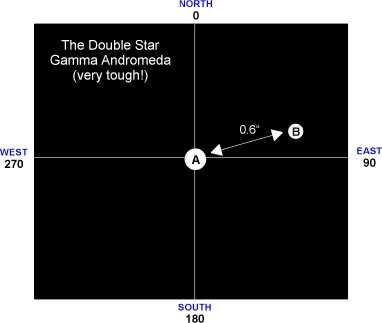
Object 4 - The "Universal Standard Double Star Test" for a Good 8" Telescope - 36 Andromeda
So you think you've got GOOD optics in that ETX 125 or LX 90 telescope? Let's put them to the test. Some people say this star is "easy in a 6" reflector," while I have heard from others who cannot split the star with a classic 12.5 inch Cave Astrola. Indeed, I have seen both stars in my 6" refractor under very steady skies, yet a 24" telescope fails to show them cleanly separated. This is a star that defies physics, predictability and logic. So I am not ABOUT to tell you if you can or cannot resolve the star. It should be resolved, but barely, in the ETX 125 and certainly if your optics are well collimated in the LX 90. Presently the separation is given in many sources as 1.1" arc, but the star will seem much more difficult. The brighter star, 36 Andromedae at magnitude 6.2, is located at the same distance as Alpheratz from Earth; its companion - at magnitude 6.7 - is in true orbit around the star, and presently can be found nearly DUE NORTH of the slightly brighter primary; so look in a north-south orientation using very high magnification (about 50x per inch should be required). Overall the combined brightness of these two stars provides for a naked eye object of magnitude 5.4.
Object 5 - Here's One for Everybody! - 59 Andromedae - A Fine Double Star
This double star is sure to please everyone, although not as colorful and as bright as many others. The primary star is magnitude 6.0 and thus visible in small finderscopes; located nearly NE from that star is a slightly dimmer magnitude (6.7) star about 17" arc distant. Use medium to medium-high (about 15x to 25x per inch aperture) to see this pair the best. There IS a color contrast here if your eyes are good. The fainter star "might" appear very brilliant white or bluish white, while the brighter star should appear yellow or even yellow-orange...use higher magnifications to help bring out any color that you might "think" you see!
Object 6 - Here is a Wild One: "Groombridge 34 (GRB34)" - A Double Red Dwarf Star!
This one will most definitely be your "GO TO" USER OBJECT for Andromeda so you might go ahead and make a note of it. I chose it because it is remarkably interesting, both in fact and in vision. GRB 34 is the designation for a pair of RED DWARF stars - highly evolved "late" spectral stars of very small mass....as a matter of fact INCREDIBLY small mass. The larger star (magnitude 8.1) is only 1/6000 the mass of our own sun!! Think that is impressive? How about the smaller (magnitude 10.9) star, with its mass an astounding 1/40,000th smaller than the sun. Now are you impressed? NOW do you see why I want this object on your "User Object" library list of the unusual and weird?
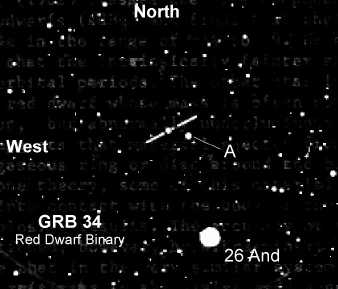
GRB 34 is actually visible in the ETX 60 and 70, but you must know which star you are looking for in such a low power and wide field. Once a suspected star (look for a VERY red stellar object) is found in any scope, always begin slowly increasing the magnification until you finally are able to resolved into two components. This one should not be difficult, as the two stars are a full 39" arc apart, almost the same distance that Jupiter would fill in the same eyepiece. It is the faintness of the secondary that makes them difficult for discovery in the smaller telescopes.
Object 7 - In the sky!! Is it a bird....a plane....a variable star....a nova? Heck, we have no idea!
This star - Z Andromedae - is a most unusual variable and one that is frequently classified as a "recurrent nova" by astronomers. You can make a career out of this unpredictable and erratic star.
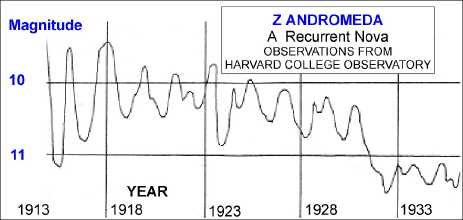
Looking at the Harvard Observatory records in the light curve above you can see that Z Andromedae reached a peak (BACK-AND-FORTH!) three times from 1913 through 191 and then began to slowly continue to peak....but a bit less each time. Major outbursts of the this star CAN be seen to have some type of regularity - about 695 days to be exact - but each time the star does NOT attain a brightness equal to the time before. Increases of up to two full magnitudes are dramatically rapid, followed by equally rapid declines! But notice what happened after about 1933 when the star decided it might be time to "rest" again.
To locate and monitor this wonderful variable star - suitable for long-period observing with the ETX 90 and all telescopes larger - you merely log onto the web site of the American Association of Variable Star Observers (AAVSO) for valuable observing information and locator/comparison charts. As has been frequently mentioned in these "GO TO" TOURS, a variety of charts is always available for nearly every variable star known. For these charts, the AAVSO has selected very constant and stable comparison stars with exact magnitudes provided with which the variable can be compared. The "a" scale charts are naked-eye locator charts for brighter stars that required brighter comparison stars across the sky; "b" is slightly smaller scale with fainter stars; "c" is telescopic at medium magnification with stars typically visible in the ETX 90 and larger scopes, while the "d" charts reach as faint as magnitude 14 and below. To assist in locating the star each time, refer to the link: charts.aavso.org/STANDARD/AND/Z_AND/ZAND-BR.GIF for the "b" chart (reversed for your catadioptic telescope field of view!). Then, once found, go the more narrow field and higher-power chart: charts.aavso.org/STANDARD/AND/Z_AND/ZAND-DR.GIF to assist in detail comparison stars with specific confirmed magnitudes. I know that the AAVSO would greatly appreciate your weekly or monthly estimates of this unusual star's brightness changes!
Z Andromeda is actually a pair of stars, one red and one blue in the spectral range. Each is known by astronomers now as a variable in and of itself, both varying in synchronicity of some 700 days.....THAT in itself is a remarkable thing to ponder! Something to think about on the next cloudy night.
Object 8 - Galactic Cluster NGC 752 - A Very Nice LARGE Cluster, Ideal for the ETX 60 & 70!
Here's where the ETX 60 and 70 wide field refractors get all the other telescopes back....this beautiful but large cluster is all but lost in telescopic views; in fact, before the popular ETX 60 and 70 was introduced, either a large pair of good binoculars or a very expensive richest field refractor would have been the instrument of choice to view this cluster. NGC 752 is much like other familiar clusters; at 1300 light years away, it is much farther and older than M44, the "Beehive" or Praesepe in Cancer, than the Hyades in Taurus (the closest star cluster to Earth at only 150 Light years) and the slightly more distant Pleiades, only 450 light years away. In spite of its brightness of 7.0, this is a very faint overall cluster because of its size, nearly 1.5 times larger than the diameter of the moon as we see it from Earth.
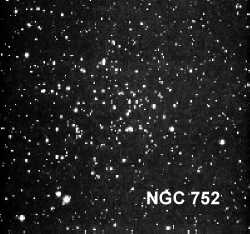
Nonetheless, of its 70-odd stars - all of which are visible in the ETX 125 and LX 90, sixteen of them are easily viewed in the smaller telescopes, with magnitudes from 8.9 to slightly fainter than 10th. The nice wide field photograph taken with astrographic equipment at Lowell Observatory shows how effective the wide field of view can be. The field in this photo (above) is wider than is possible to attain with either the ETX 125 or the LX 90, yet most stars seen in this photograph ARE visible in both telescopes.
Object 9 - The Beautiful (but faint!) Edge-on Spiral Galaxy NGC891
This edge-on galaxy, though pretty, is NO rival to ngc4565 that I featured and discussed in detail in our "GO TO" TOUR of Coma Berenices. (see http://www.weasner.com/etx/ref_guides/coma-berenices.html ). They both are very similar, yet this one in Andromeda, at magnitude 10.9 is much fainter and more difficult to view; also it is smaller, at 11.8' x 0.8' arc, still very large for a deep sky object. However, remember that ngc4565 will literally stretch from one edge of a 32mm wide field Plossl to the other in both the ETX 125 and LX 90 on a very dark night - almost one degree. This galaxy appears about one-half that extent, but is still a very nice object in the larger scopes. At least the ETX 90 is necessary for adequate views of this sliver of light. At a distance of 43 MILLION light years, this galaxy is believed to stretch 120,000 light years across, yet STILL is a smaller galaxy that the Great Andromeda Galaxy featured below! In the Mount Wilson 60-inch reflector photograph below, compare the similarities of this galaxy with ngc4565 at the link above. They are - photographically at least - remarkable similar; however visually there is a significant difference in the view. A very dark night and medium magnification is necessary to view this long shaft of light, regardless of which telescope is used.
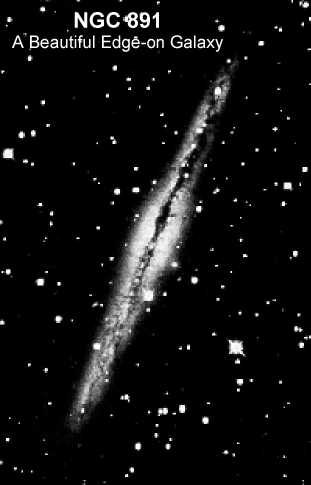
Object 10 - A Lone Planetary Nebula, NGC 7662
This is a very difficult object, although its relative brightness given in all references (8.9) suggests otherwise. The overall size is "about" the diameter of Saturn's globe (not with rings) seen in the same eyepiece, so you can appreciate that it is relatively small. However, the ETX 90 will definitely reveal its small disk-like appearance of blue-green ghostly glow. Larger telescopes may exhibit the annual or "ring-like" shape (see the drawing below by E.E. Barnard from 1907 through the great 40" Yerkes telescope - this drawing very closely matches visual impressions through the LX 90, but with NO central star visible in the 8" scope).
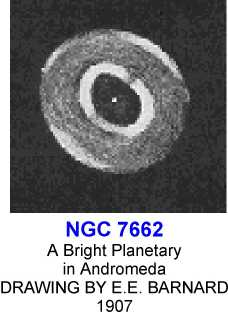
Although the central star for this planetary nebula - a shell of stellar gases emitted by the explosion of an unstable star - is fairly bright (12.5 magnitude), it is VERY difficult to see visually except in very large telescopes; the reason is that there is much extraneous gases that block the visible wavelengths of light to the eye; averted vision in the LX 90 will reveal the star but only with a magnification of up to 400x and the darkest of nights. The star IS a variable, changing in brightness unpredictably from the 12th magnitude all the way down to 16th magnitude....so if you cannot see it in an 8" or larger scope: try again another night! In the ETX 90 and larger, expect to see a true elliptical - not circular - shape to this nebula; higher powers (about 30x per inch minimum) are recommended to see both detail and the pretty blue-green glow of this interesting planetary nebula
Objects 11 - Our Final Objects and Grande Finale! The Galaxy Triplet: Messiers 31 and 32 & NGC 205!
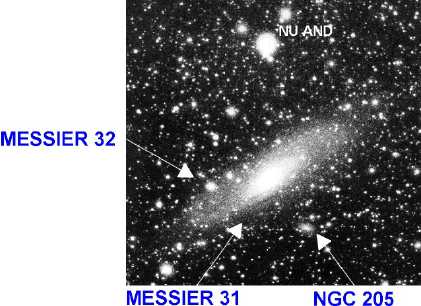
There are memorable deep sky objects that are familiar naked eye targets. Which one is your favorite? Perhaps the best known is the Pleiades, or Messier 45 in Taurus, which many unfamiliar observers mistake for "the little dipper." Others include: Messier 44 (Praesepe) in Cancer, the Hyades in Taurus, the Great Orion Nebula in Orion and - of course - the Great Andromeda Galaxy, Messier 31 in Andromeda. As seen in the simple photography at the beginning of this guide, this object is a beautiful and striking reminder of just how vast the Universe really is and frequently serves to humble mankind through its vastness. Obviously, the fabulous near-twin to our own Milky Way, this galaxy has been known by mankind as long as it has been on this Earth. However, the earliest pseudo-scientific recording of the object was by the Persian star recorder Al-Sufi in about AD 905 who noted it as the "little cloud" in his Book of Fixed Stars; it must have been observed by Chinese and Persian astronomers even earlier. There have been many "multiple independent discoveries of the Great Andromeda Galaxy. Unaware of the Persian records of this object, the French comet hunter and "faint fuzzy" cataloger Charles Messier pretty much inferred that he was the first to actually pin down the coordinates of the object. who was the first to give a telescopic description in 1612. Unaware of both discoveries, Giovanni Hodierna independently "discovered" this object around 1654. Edmund Halley, however, gives credit for the discovery of this "nebula" to the French astronomer Ismail Bouillaud who observed it in 1661even though Bullialdus mentions that it had been seen 150 years earlier (in the early 1500s) by someone else. I, too, have "discovered" this object so you can add my name to the list as well.
Simon Marius, in 1611, describes the "nebula" as "...the light of a candle shining...through horn," a very beautiful and poetic overview of just how it looks today.
The huge galaxy, in spite of all the "discoveries" is known as Messier 31 today, or NGC 224. In my LX 90, you can clearly make out the dark dust lane in the northwest part, just away from the core, or "central hub" of the brightest part of the galaxy (see the photograph below). Best views of this by far are in very low power and wide field instruments, and thus the ETX 60 and 70 richest field refractors have a distinct advantage to this huge object.
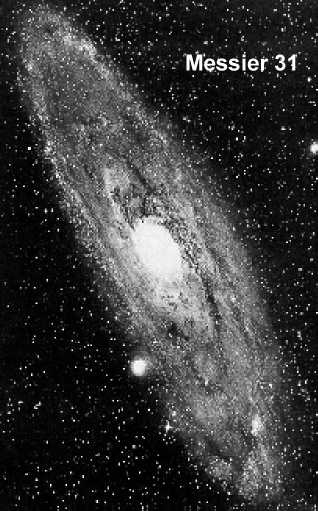
The visual size of this object is phenomenal. Its length can be seen for a good 3 degrees (six lunar disks!) in a good pair of 10 x 50 binoculars on the darkest nights. It width (since it is tilted to our line of sight) is about equal to the diameter of the moon from Earth (about 35' arc). Although only listed as magnitude 4.1, the Andromeda Galaxy appears to be an object of much greater magnitude, simply because of its large extended size.
One of the largest spiral galaxies known to exist, and over 2.3 million light years away, Messier 31 is the closest spiral galaxy to our own Milky Way. The southern sky Magellanic Clouds are closer but are considered as irregular or peculiar galaxies, and unlike our own star system. As part of the "Local Group," this fabulous galaxy is teamed up gravitationally with others in the neighborhood including: Our Milky Way, both Large and Small Magellanic Clouds, Messier 33 in Triangulum, NGC 6822 (Sagittarius), IC 1613 (Cetus) and galaxies in what we describe as the "Fornax" and "Sculptor" system. In addition the TWO companion galaxies to the Great Andromeda Galaxy - Messier 32 and NGC 205 - are also members of the Local Group.
Messier 32 is a faint (9th magnitude) fuzzy appearing object that is clearly distinguishable in the ETX 90 and larger scopes and is found very close (24' arc due south) from the central hub of Messier 31. It actually SMALLER than the other companion - NGC 205 - which is a large, diffuse blur in the ETX 90 and clearly shows with the ETX 60 and 70 as well. Both of these companions are elliptical galaxies.
Observers using the ETX 125 and LX 90 should venture even further to find yet TWO MORE companion galaxies to the Great One. About 7 degrees north in Cassiopeia you will find NGC 185 (Mag. 10.3) and NGC 147 (Mag. 12.1) which are definitely observable in our larger scopes. You will find them listed in the AutoStar "Deep Sky" object library.
----------------------------------
WANDERING ABOUT....YOUR NEW "USER OBJECT" IN ANDROMEDA
I alerted you to the fact that [Groombridge34 - R.A. 00h 16' / DEC + 43 44 - Mags: 8.1 & 10.9 ] would most definitely be our G"GO TO" TOUR User Object for Andromeda. How can I resist...you already have white dwarfs, black holes, X-ray stars....why not a pair of red dwarfs to go with all this?
On AutoStar, go to: "Select/Object [enter]...." scroll down to "User Object" [ enter]. Now enter the coordinates given above for "GRB 34", using the number keys on AutoStar. After entering the coordinates and pressing "Enter" yet again, scroll down one and you can list the magnitude of the object as "8"[Enter].
Now you have yet another unique and oft-overlooked deep sky object for conversation-starters and crowd-stoppers at your next star party or club outing.
Next Constellation GO TO" TOUR Installment: TRIANGULUM, another in a series of "left-over stars" that some later astronomer - in this case the Frenchman Lacaille - decided should be grouped into a constellation of sorts simply because Ptolemy had not "used up" all the stars to his liking. Nonetheless, Triangulum - with its huge Pinwheel Galaxy, Messier 33, survived the final cut of the International Astronomical Union (IAU - see http://www.weasner.com/etx/ref_guides/lacerta.html ). Surprising to most observers, this tiny constellation contains a wealth of great objects for modest and small telescopes! We will explore several nice galaxies and several beautiful double stars that await our "GO TO" constellation tour into Triangulum.
Good Observing and may the stars serve as your sentries as you explore the frontiers of space!
P. Clay Sherrod
Arkansas Sky Observatory
Conway / Petit Jean Mountain
Arkansas
Return to the top of this page.
Go back to the Observational Guides & References page.
Go back to my ETX Home Page.